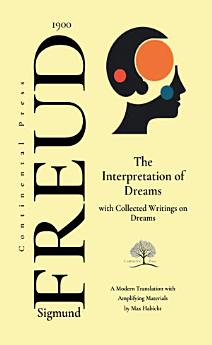The Interpretation of Dreams: and Collected Writings on Dreams
May 2024 · The Collected Complete Works of Sigmund Freud Book 9 · Continental Press
Ebook
350
Pages
family_home
Eligible
info
reportRatings and reviews aren’t verified Learn More
About this ebook
“The interpretation of dreams is the royal road to a knowledge of the unconscious activities of the mind.” A modern rendering of Sigmund Freud’s seminal 1900 work The Interpretation of Dreams (Die Traumdeutung), including the three prefaces he wrote for different editions, along with five additional writings exclusively focused on dream analysis and metapsychology. This comprehensive collection brings together Freud’s most significant works on dreaming, offering a profound exploration of the unconscious mind and its symbolic expressions. The included texts are: 1900: Die Traumdeutung / Interpretation of Dreams 1911: Träume im Folklore / Dreams in Folklore 1913: Ein Traum als Beweismittel / A Dream as Evidence 1913: Märchenstoffe in Träumen / Fairy Tale Elements in Dreams 1922: Traum und Telepathie / Dream and Telepathy In The Interpretation of Dreams, Freud introduces the revolutionary idea that dreams are the “royal road to the unconscious,” serving as a window into repressed desires, unresolved conflicts, and hidden aspects of the self. He argues that dreams fulfill unconscious wishes and are composed of latent content (hidden meanings) disguised by manifest content (the dream’s surface narrative). Through detailed analysis of his own dreams and those of his patients, Freud demonstrates how dream symbols, condensation, displacement, and secondary revision reveal the workings of the unconscious mind. The additional writings in this volume expand on Freud’s theories, exploring the cultural, mythological, and even paranormal dimensions of dreams. Dreams in Folklore examines the role of dreams in traditional stories and cultural practices, while A Dream as Evidence investigates the use of dreams in legal and moral contexts. Fairy Tale Elements in Dreams explores the parallels between dream symbolism and mythological motifs, and Dream and Telepathy delves into the controversial intersection of dreams and psychic phenomena. This fresh, modern translation from the original German manuscript breathes new life into these historically significant works. Freud’s extensive writings have often been inaccessible to the general reader, and this edition seeks to bridge that gap by providing direct access to his original ideas. The Reader’s Edition introduces Freud’s work in context, with an illuminating Afterword that explains his philosophical project, situates it within the Modernist milieu, and explores its enduring impact on contemporary thought. The Afterword also examines the relationship and intellectual conflict between Freud and Carl Jung, particularly their differing views on dream interpretation. While Freud saw dreams as expressions of repressed desires, Jung viewed them as manifestations of the collective unconscious, filled with archetypal symbols that guide individuation and self-realization. Accompanied by a timeline of Freud’s life and works, an index of philosophical terminology, and a short biography, this edition is an indispensable resource for students, scholars, and anyone interested in the origins of psychoanalysis. The inclusion of supplemental materials, such as illustrations and a glossary of Freudian psychological terms, enhances the reader’s understanding of this complex and historically important work. Whether you are a seasoned scholar or a curious newcomer, this volume offers a comprehensive and accessible introduction to Freud’s groundbreaking theories on dreams and the unconscious mind.
About the author
Sigmund Freud (1856-1939) was an Austrian neurologist and the founder of psychoanalysis, a groundbreaking approach to understanding the human psyche. Freud introduced concepts such as the unconscious mind, repression, and the tripartite structure of the psyche, which includes the id, ego, and superego. His work, including seminal texts like The Interpretation of Dreams and Beyond the Pleasure Principle, emphasized the role of unconscious drives and childhood experiences in shaping behavior and personality. Freuds theories on sexuality, defense mechanisms, and dream analysis challenged societal norms and profoundly altered the field of psychology, influencing literature, art, and philosophy. Though controversial, his contributions laid the foundation for modern psychotherapy and continue to spark debates and inspire new approaches to understanding human behavior and mental processes.
Rate this ebook
Tell us what you think.
Reading information
Smartphones and tablets
Install the Google Play Books app for Android and iPad/iPhone. It syncs automatically with your account and allows you to read online or offline wherever you are.
Laptops and computers
You can listen to audiobooks purchased on Google Play using your computer's web browser.
eReaders and other devices
To read on e-ink devices like Kobo eReaders, you'll need to download a file and transfer it to your device. Follow the detailed Help Center instructions to transfer the files to supported eReaders.











